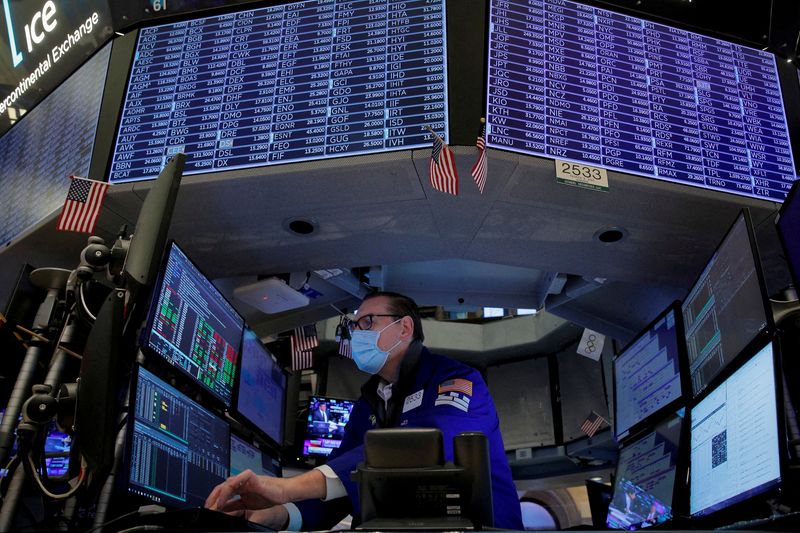
© Reuters Dow Jones, Nasdaq, S&P 500 weekly preview: Q2 earnings season is here
The fell 1.2% last week as analysts continue to warn that the stocks are due for a pullback. For the first time in 4 months, the S&P 500 lost at least 0.25% on two consecutive days.
Similarly, the tech-heavy index dropped 0.9% as Apple (NASDAQ:) lost 1.7%. fell as much as 2% as bulls continue to struggle at the 34600 resistance.
“We continue to see evidence of waning momentum out of secular growth names (FANG+, Semis, etc) and are sticking with our call to fade seasonal July strength in the Nadsaq and see that as having the biggest downside risk here,” BTIG technical strategists said in a client note.
As of Friday, the forward 12-month P/E ratio for the S&P 500 is 18.9, which is above both the 5-year average (18.6) and the 10-year average (17.4).
This week’s focus is on the on Wednesday, the University of Michigan on Friday, and the beginning of the Q2 earnings season. Moreover, a number of Fed officials – including governors and , and presidents , , , Barkin, and – are scheduled to speak this week.
Q2 earnings season is here
The Q2 earnings season is set to start later this week when a number of banks are due to report on their performance for the April quarter. Analysts forecast a decline of 7.2% year-over-year, according to FactSet, worse than the March 31 consensus for a decline of 4-7%.
“With nearly all of the price performance this year attributable to multiple expansion, do earnings matter? While earnings revisions breadth has improved this year, calendar EPS forecasts continue to fall. Higher rates and lower liquidity suggest P/Es are vulnerable unless EPS forecasts rise,” Morgan Stanley equity strategists wrote in a note.
Companies that are due to report this week include Delta Air Lines (NYSE:), PepsiCo (NASDAQ:), BlackRock (NYSE:), Citigroup (NYSE:), JPMorgan & Chase (NYSE:), Wells Fargo (NYSE:), and UnitedHealth Group (NYSE:).
“The bar for earnings remains low but we still see a small miss of less than 1% for Q2 EPS reporting, as compared to the historical median beat of ~3%. Thus far early reporters have had a median positive surprise of 4.2% (see Q2 reporting summary), and yet the S&P 500 aggregate EPS has been revised down by around 1% since the start of the earnings,” UBS strategists said.
What analysts are saying about US stocks
Morgan Stanley: “While 2Q results are unlikely to solidify the bull or bear earnings case for 2H, we think stocks will need more confirmation of the turn in growth than they have over the past 6 months given higher valuations, deteriorating liquidity, and proximity to the second half when consensus expects a recovery—i.e., “better than feared” is likely no longer good enough.”
Bernstein: “Tech is now trading at a 54% premium to the market, its highest level in 45 years other than the dot com bubble, and well above its historical average premium of 26%… We struggle to recommend an overweight in tech for the second half, and believe stock picking increasingly matters, particularly since the five largest tech companies account for nearly 56% of tech’s total capitalization (and the top 2 account for 33%), three of which are at very high relative valuations (95%+) vs. history.”
Citi: “After a solid 1H, US outperformance may go on pause. We downgrade the US to Neutral, while upgrading Europe to Overweight. The European market is trading at a record discount to the US and is pricing in a more reasonable EPS growth path… Our US Strategy team thinks megacap Growth is set for a pullback, while US recession risks could still bite.”
JPMorgan: “FOMO is in full swing, there is complacency being built into stocks with at the lows of its range. All this suggests that, if the activity momentum does weaken in 2H, relative to the current projections of no/soft landing, stocks are unlikely to shrug it off, or look through, as they are not priced for disappointment anymore, even if one is to fully take out the Tech/AI/FAANG groups from the equation. Low beta sectors would outperform against that backdrop.”
BTIG: “Despite the weakness, SPX continues to respect its rising 20 DMA (4383). That is the first bogey for bears, but ultimately they need to break back under 4,300 to get any real traction. We continue think 3Q represents an opportunity to rent value over growth.”
Baird: “Inflation has come off of its peak level of 9% all the way down to 4%, so that’s a plus. On valuation, however, there’s still work that needs to be done, especially after the recent rally. And then lastly, organic drivers of growth. This one has proven more elusive given the difficult operating environment. And while AI has now become all the rage, it remains to be seen whether it can be that long-term organic driver of growth that we need.”





